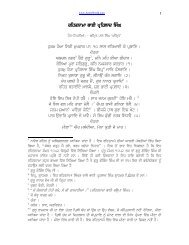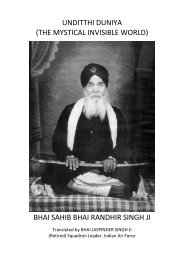Guru Gobind Singh's Death at Nanded Examination of - Vidhia.com
Guru Gobind Singh's Death at Nanded Examination of - Vidhia.com
Guru Gobind Singh's Death at Nanded Examination of - Vidhia.com
You also want an ePaper? Increase the reach of your titles
YUMPU automatically turns print PDFs into web optimized ePapers that Google loves.
^ mm<br />
36 AN EXAMINATION OF SUCCESSION THEORIES<br />
Bayan-i-Khandan-i-Karam<strong>at</strong> Nishan-i-Bedidn from the time <strong>of</strong><br />
<strong>Guru</strong> Nanak to th<strong>at</strong> <strong>of</strong> Baba Suj an Singh. It was <strong>com</strong>pleted<br />
in May 1865. The first sixty-five pages <strong>of</strong> the work are"<br />
devoted to the account <strong>of</strong> the Ten <strong>Guru</strong>s which ends with the<br />
de<strong>at</strong>h <strong>of</strong> <strong>Guru</strong> <strong>Gobind</strong> Singh <strong>at</strong> <strong>Nanded</strong> in 1765 Bikrami,<br />
1708 A.D. According to it :<br />
When on K<strong>at</strong>ik Sudi 5, 1765 Bikrami, <strong>Guru</strong> <strong>Gobind</strong> Singh was<br />
about to die <strong>at</strong> <strong>Nanded</strong> in the Daccan, all the Singhs and disciples<br />
asked him as to who would be the future <strong>Guru</strong>. The <strong>Guru</strong> then<br />
said : "<strong>Guru</strong> Khalsa! Khalsa <strong>Guru</strong>. He who shall observe the Sikh<br />
rahit or the rules <strong>of</strong> conduct and morality and medit<strong>at</strong>ion, him<br />
know ye to be my very self." Then thinking th<strong>at</strong> there should be<br />
a definite .centre <strong>of</strong> faith for all the Sikhs, the <strong>Guru</strong> with five paise<br />
and a coco-nut in his hand (as <strong>of</strong>fering) bowed before the <strong>Guru</strong><br />
Granth Sahib and said : "Ye all <strong>com</strong>munity should recognize the<br />
<strong>Guru</strong> Granth Sahib as the <strong>Guru</strong> after me and obey the <strong>com</strong>mandments<br />
contained therein." And then he uttered the following couplet :<br />
?1 3J5 *fl H1 ^ V312 313 <strong>of</strong>t §tJ I<br />
fl fn*t yftj ftraq BS 5fl fsrft H 83 11<br />
[ Pp. 64-65, Appendix IX.]<br />
Recognize the <strong>Guru</strong> Granth as the visible body <strong>of</strong> the <strong>Guru</strong>.<br />
The Sikh who wishes to meet me should find me therein.<br />
In this the author <strong>of</strong> the Bayan has reiter<strong>at</strong>ed the last<br />
<strong>com</strong>mandment <strong>of</strong> <strong>Guru</strong> <strong>Gobind</strong> Singh in the words <strong>of</strong> his<br />
contemporary and well-known disciple Bhai Nand Lai who<br />
was present <strong>at</strong> <strong>Nanded</strong> <strong>at</strong> the time <strong>of</strong> the <strong>Guru</strong>'s de<strong>at</strong>h. There<br />
could be no better and more reliable authority than him on<br />
the subject.<br />
The author <strong>of</strong> the Bayan is all devotion and praise for<br />
Baba Sahib Singh Bedi <strong>of</strong> Una, whom he has called <strong>Guru</strong> Sahib<br />
throughout his book. He also tells us th<strong>at</strong>, according to<br />
<strong>Guru</strong> <strong>Gobind</strong> <strong>Singh's</strong> promise, he was reborn in the house<br />
<strong>of</strong> Baba Kaladhari Bedi as his grandson—Sahib Singh, [pp.57-8,<br />
66.] But in spite <strong>of</strong> it, Munshi Sant Singh does not claim<br />
formal <strong>Guru</strong>ship for him in place <strong>of</strong> the Tenth <strong>Guru</strong><br />
who, he says, had formally declared the <strong>Guru</strong> Granth Sahib to<br />
. betheGwrw after him. Born in 1756 A.D., within forty-eight<br />
years <strong>of</strong> the Tenth <strong>Guru</strong>'s de<strong>at</strong>h and being the most<br />
respected Sikh <strong>of</strong> his time, <strong>com</strong>manding overwhelming influence<br />
GURU GOBIND SINGH'S DEATH AT NANDED 37<br />
with the Sikh Sardars, Rajas and Maharaja Ranjit Singh, he<br />
had a better chance than all the l<strong>at</strong>er pretenders. Baba<br />
Sahib Singh, however, preferred to be an humble disciple,<br />
a Sikh <strong>of</strong> <strong>Guru</strong> <strong>Gobind</strong> Singh— a Khalsa—than to pretend to<br />
be an equal <strong>of</strong> his. In 1780 he presented himself <strong>at</strong> Dera<br />
<strong>Guru</strong> Tegh Bahadur <strong>at</strong> Anandpur and received Khande ki<br />
Pdhul, the Amrit <strong>of</strong> the Khalsa, there. According to the<br />
Bayan, Baba Sahib Singh was the first <strong>of</strong> the Bedis to<br />
receive the Khalsa baptism which he himself l<strong>at</strong>er on adminis^<br />
tered from time to time to a large number <strong>of</strong> Sikhs throughout<br />
the country.<br />
We now <strong>com</strong>e to the last two important Sikh poets <strong>of</strong><br />
the nineteenth century, Bawa Sumer Singh and Giani Gian<br />
Singh. Bawa Sumer Singh is the author <strong>of</strong> the Pothi Gur-bilds<br />
ki which was <strong>com</strong>pleted in 1873 and published in 1882 A.D.<br />
Therein he tells us in unambiguous language th<strong>at</strong>, when the<br />
<strong>Guru</strong> was preparing for his de<strong>at</strong>h, he told the Sikhs present<br />
th<strong>at</strong> he was placing the Khalsa in the lap <strong>of</strong> the Almighty God<br />
and th<strong>at</strong> he would ever be present in the Khalsa. He then<br />
declared th<strong>at</strong> <strong>Guru</strong> Granth Sahib would be the <strong>Guru</strong> after him.<br />
After this he departed for heaven—prabhu pralok pramana<br />
[ p. 704J. The formal install<strong>at</strong>ion <strong>of</strong> the <strong>Guru</strong> Granth Sahib<br />
is again repe<strong>at</strong>ed on page 706. [Appendix XL]<br />
Then begin the poetical flights <strong>of</strong> the author who, in<br />
the words <strong>of</strong> Babu Jagann<strong>at</strong>h Das R<strong>at</strong>nakar <strong>of</strong> Ayodhia,<br />
was one <strong>of</strong> foremost poets <strong>of</strong> Braj-bhasha <strong>of</strong> his days. He<br />
has not only improved upon the le'gends about the wood-cutter,<br />
the Udasi sadhu and the Rai brothrs <strong>of</strong> Janwara, mentioned by<br />
Bhai Suka Singh in his Gur-bilds, but has also added to them<br />
two more legends about the supern<strong>at</strong>ural visits <strong>of</strong> <strong>Guru</strong><br />
<strong>Gobind</strong> Singh to Bir<strong>at</strong> in Peshawar area and to a place<br />
known as Kotha Sahib <strong>at</strong> a distance <strong>of</strong> about eight kos from<br />
Kabul in Afghanistan. But they all, as usual, belong to the<br />
dreamland, the world <strong>of</strong> imagin<strong>at</strong>ion, or the world beyond,<br />
but not to this human world <strong>of</strong> ours. As such, they are not<br />
worthy <strong>of</strong> the notice <strong>of</strong> an objective student <strong>of</strong> history and<br />
deserve to be dismissed as incredible fables.




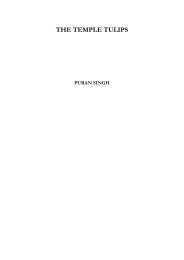
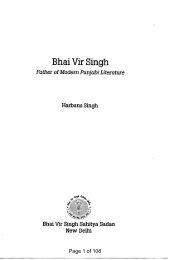

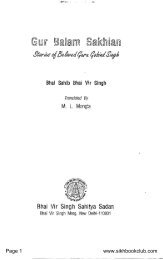
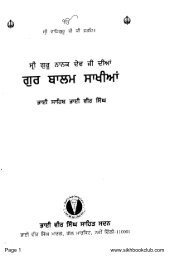
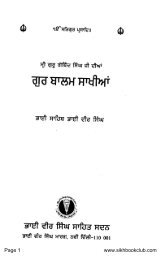
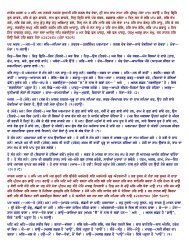
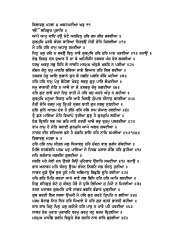

![cOpeI ] hmrI kro hwQ dY r~Cw ] pUrn hoie ic~q kI ie ... - Vidhia.com](https://img.yumpu.com/12240258/1/190x245/copei-hmri-kro-hwq-dy-rcw-purn-hoie-icq-ki-ie-vidhiacom.jpg?quality=85)
